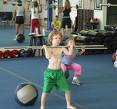21
May 10
I know that many of my clients are parents and have questions regarding fitness and kids. So, here’s an article I wrote for you…let me know your thoughts in the comment section!
 Children are probably the most at risk population for disease if current health-lifestyles are maintained. The current generation lives in a world where physicality is virtually unnecessary and often considered a hobby or luxury. Even the act of walking to school is negated by busing or over cautious parents who drive children to school daily. The fact is that we live in a world where it’s difficult for parents to tell their children to ‘just go out and play!’ What’s a parent to do? Everyone knows the benefits of exercise; however, knowing what that looks like is another story.
Children are probably the most at risk population for disease if current health-lifestyles are maintained. The current generation lives in a world where physicality is virtually unnecessary and often considered a hobby or luxury. Even the act of walking to school is negated by busing or over cautious parents who drive children to school daily. The fact is that we live in a world where it’s difficult for parents to tell their children to ‘just go out and play!’ What’s a parent to do? Everyone knows the benefits of exercise; however, knowing what that looks like is another story.
‘Do as I do’
 The first thing that parents need to do is get off the couch. The most powerful lesson a child learns is the modeled behavior he or she sees. A parent loses all credibility with the ‘do as I say not as I do’ mentality. Just as a child becomes a better reader by witnessing their parent reading, learns spirituality by witnessing their parent living their faith, or learns healthy eating by watching parents make healthy food choices; a child will be more likely to follow and value a fitness regime if they see its part of their parents’ balanced life. An even more powerful lesson is for the parent to involve themselves in an activity with their child.
The first thing that parents need to do is get off the couch. The most powerful lesson a child learns is the modeled behavior he or she sees. A parent loses all credibility with the ‘do as I say not as I do’ mentality. Just as a child becomes a better reader by witnessing their parent reading, learns spirituality by witnessing their parent living their faith, or learns healthy eating by watching parents make healthy food choices; a child will be more likely to follow and value a fitness regime if they see its part of their parents’ balanced life. An even more powerful lesson is for the parent to involve themselves in an activity with their child.
What’s your passion?
The second thing needed is to find a child’s passion. Many parents try to live vicariously through their children and have the child  participate in the sports or activities that the parent is passionate about. This only leads to frustration for both parties. Sometimes it takes a great deal of experimentation to find an activity that children want to do on a regular basis. Parents also have a difficult time with the nature of the activity. We live in society where children are organized to death. If the activity isn’t programmed, it seems to lose value in the eyes of parents. If a child is passionate about playing the piano and the only activity they like seems to be playing at the park, this is fine. Any activity a child participates in regularly that provides some of the components of fitness is super. The major components of fitness include: muscular strength and endurance, cardiovascular fitness, fine and gross motor coordination and flexibility. A parent need only ask themselves if any of these are addressed in the activity to realize the value of the activity. Many children don’t have the aptitude for athletic performance just as many adults fail miserably in sport related pursuits. It goes without saying though that some type of daily fitness is still a necessary part of a healthy and balanced life. The nature of the pursuit needs to be kept in perspective. Some people are just not cut out for competitive sport, team sport or artistic type activities such as dance or figure skating, but there is certainly something fitness related for everyone.
participate in the sports or activities that the parent is passionate about. This only leads to frustration for both parties. Sometimes it takes a great deal of experimentation to find an activity that children want to do on a regular basis. Parents also have a difficult time with the nature of the activity. We live in society where children are organized to death. If the activity isn’t programmed, it seems to lose value in the eyes of parents. If a child is passionate about playing the piano and the only activity they like seems to be playing at the park, this is fine. Any activity a child participates in regularly that provides some of the components of fitness is super. The major components of fitness include: muscular strength and endurance, cardiovascular fitness, fine and gross motor coordination and flexibility. A parent need only ask themselves if any of these are addressed in the activity to realize the value of the activity. Many children don’t have the aptitude for athletic performance just as many adults fail miserably in sport related pursuits. It goes without saying though that some type of daily fitness is still a necessary part of a healthy and balanced life. The nature of the pursuit needs to be kept in perspective. Some people are just not cut out for competitive sport, team sport or artistic type activities such as dance or figure skating, but there is certainly something fitness related for everyone.
What about weight lifting for kids?
 Many parents have asked me if this is an appropriate activity for children. My first response is: ‘is your child interested in weight training?’ The health benefits are numerous, but if the interest is not there, it is a futile attempt for everyone. Weight lifting is not for all adults, even with the wonderful health benefits, it shouldn’t be expected for children to enjoy something just because it’s ‘good for them’. Once it’s established that a child is interested in resistance training, other issues can be discussed. The age of the child is important. Children that actually benefit most are preteens and teenagers. The five and six year old should be involved in activities to develop body awareness and control, balance and running, jumping and throwing type activities. For the older child, athletic performance can be greatly improved through sport related weight training, as well, weight training as a fitness endeavor on its own has merit. The emphasis on any resistance training for children should be on proper form and technique, often using the child’s own body weight. There is a vast difference between weight training and power lifting. In the latter, the emphasis is on lifting maximum poundages which can be unhealthy for the younger child. Proper weight training can enhance bone mass density and in no way ‘stunts’ growth through premature closure of epiphyseal junctures or growth plates. Following are some guidelines to keep in mind should your child be interested in starting a weight lifting program:
Many parents have asked me if this is an appropriate activity for children. My first response is: ‘is your child interested in weight training?’ The health benefits are numerous, but if the interest is not there, it is a futile attempt for everyone. Weight lifting is not for all adults, even with the wonderful health benefits, it shouldn’t be expected for children to enjoy something just because it’s ‘good for them’. Once it’s established that a child is interested in resistance training, other issues can be discussed. The age of the child is important. Children that actually benefit most are preteens and teenagers. The five and six year old should be involved in activities to develop body awareness and control, balance and running, jumping and throwing type activities. For the older child, athletic performance can be greatly improved through sport related weight training, as well, weight training as a fitness endeavor on its own has merit. The emphasis on any resistance training for children should be on proper form and technique, often using the child’s own body weight. There is a vast difference between weight training and power lifting. In the latter, the emphasis is on lifting maximum poundages which can be unhealthy for the younger child. Proper weight training can enhance bone mass density and in no way ‘stunts’ growth through premature closure of epiphyseal junctures or growth plates. Following are some guidelines to keep in mind should your child be interested in starting a weight lifting program:
Provide instruction. Show your child how to perform strength training exercises using controlled breathing and proper form. This is a time when a personal trainer could be of great assistance. If you enroll your child in a class, make sure there’s at least one instructor for every 10 students to ensure that your child receives proper instruction.
Supervise. Adult supervision is important to reinforce safety and good technique. As a parent, you can get involved in strength training which also serves as a positive reinforcement and provides an opportunity for a shared fitness experience.
Warm up and cool down. Have your child begin each workout with 5 to 10 minutes of a warm-up activity, such as walking, jogging in place or jumping rope. This makes muscles warm and ready for action while minimizing the risk of injury. End each workout with a cool down, including some light stretching.
Think light weights and controlled repetitions. One set of 12 to 20 repetitions at a lighter weight is all it takes. Kids don’t need weights specially sized for them; they can safely lift adult-size weights as long as the weight isn’t too heavy. The resistance doesn’t have to come from weights, either. A child’s body weight or resistance tubing can be just as effective — especially for younger kids.
Rest between workouts. Establish a rest period of at least a day between strength training workouts. Two or three sessions per week are plenty.
Track progress. Teach your child how to fill out a chart of which exercises, how many repetitions, and what weights or resistance he or she uses during a workout to help monitor progress.
Add weight gradually. Only when your child masters proper form should you add weight. If your child can’t do 10 repetitions at a certain weight, it’s too heavy; this is a recipe for injury.
Keep it fun. Vary the routine often. Kids are more likely to stick with strength training if they don’t get bored by it. It should only be one component of your child’s fitness routine. ‘Cross training’ is very important for the child athlete in order to fully develop all aspects of fitness and neuromuscular development.




 My passion is teaching people how to work fitness into their daily lifestyle in order to improve their quality of life. Let’s work together to help you reach your fitness goals!
My passion is teaching people how to work fitness into their daily lifestyle in order to improve their quality of life. Let’s work together to help you reach your fitness goals!